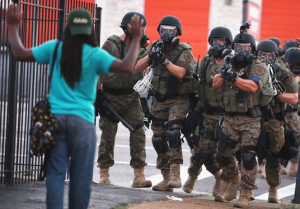How many times have you said to yourself, “Words don’t do this situation justice. I need to take a photo.” The “rhetoric” comes from your realization that the situation calls for you to do or say something. There exists what scholars call an “exigence.” (Read more about the subject in “The Rhetorical Situation” by Lloyd Bitzer.) The rhetoric is visual because your action involves the visual medium of photography.
Visual rhetoric basically means the power of visuals to reflect logos, ethos and pathos, three characteristics of all rhetoric. A compelling photograph makes you think about its logical/rational appeal, its appeal to your sense of right and wrong, and its appeal to your emotions.
Another way to think about visual rhetoric is that it enhances any kind of argument you want to make. Say you want to make a case for students picking up after themselves at lunch; you take photographs of the mess in the cafeteria. Do you see how you are making logical, ethical and emotional appeals through that image?
When you can grasp visual rhetoric you improve your “visual literacy.” Here’s an explanation from the Writing Studio at Duke University:
“Visual literacy refers to the ability to ‘read’ an image, much like the way we ‘read’ language. This form of literacy requires an awareness of ‘visual rhetoric’ – the ways that visual images communicate meaning.”
Do you have a better handle on visual rhetoric? If so, let’s get started by using six guidelines from Visual Communication: Images with Messages, by Paul Martin Lester:
“Six Perspectives for Analyzing Any Image”
- Personal: a gut reaction to the work based on subjective opinions.
- Historical: a determination of the importance of the work based on how the medium (in this case, news photography) has been used in the past.
- Technical: the relationship between light, the recording medium (camera) and the presentation of the work.
- Ethical: the moral and ethical views put forth by the producer, subject and viewer of the work, for example, Aristotle’s Golden Mean or the Judeo-Christian tradition of the Golden Rule.
- Cultural: an analysis of the symbols used in the work that convey meaning within a particular time and place.
- Critical: the ability to transcend an initial personal reaction to come up with well-reasoned ideas on society and human nature.
Let’s use these six perspectives with this 2014 image from the unrest in Ferguson, Missouri –
The caption in USA Today reads: Police force protesters from the business district into nearby neighborhoods in Ferguson, Mo., on Aug. 11. (Photo: Scott Olson, Getty Images)
A personal reaction might be, “What did this person do to attract so many heavily armed officers?” A historical reaction might be, “I remember other protest photos like this from studying the ‘60s civil rights movement.” A technical reaction could be along the lines of, “Why the soft focus on the protester?” An ethical question might be, “Is it right to shoot someone who seems unarmed and has hands up?” A cultural reaction appropriate for this scenario is, “I see the protester is imitating what witnesses saw Michael Brown doing.” Finally, a critical response might be, “Upraised hands and heavily armed police will long serve as the visual representation of the Ferguson unrest.”
Use these six points along with the questions posed in each assignment (from the Center for Media Literacy), and you’re on your way to understanding visual rhetoric.
